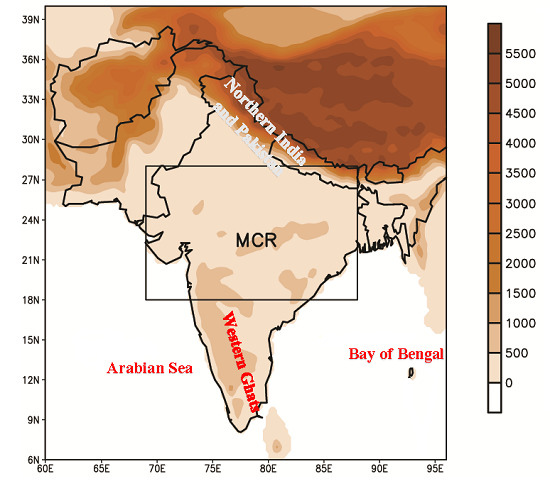An Assessment of the South Asian Summer Monsoon Variability for Present and Future Climatologies Using a High Resolution Regional Climate Model (RegCM4.3) under the AR5 Scenarios
Abstract
:1. Introduction
2. Model, Data and Experimental Design
2.1. Model Description
2.2. Experimental Design and Model Data

3. Results
3.1. Evaluation of Model Performance for Reference Period




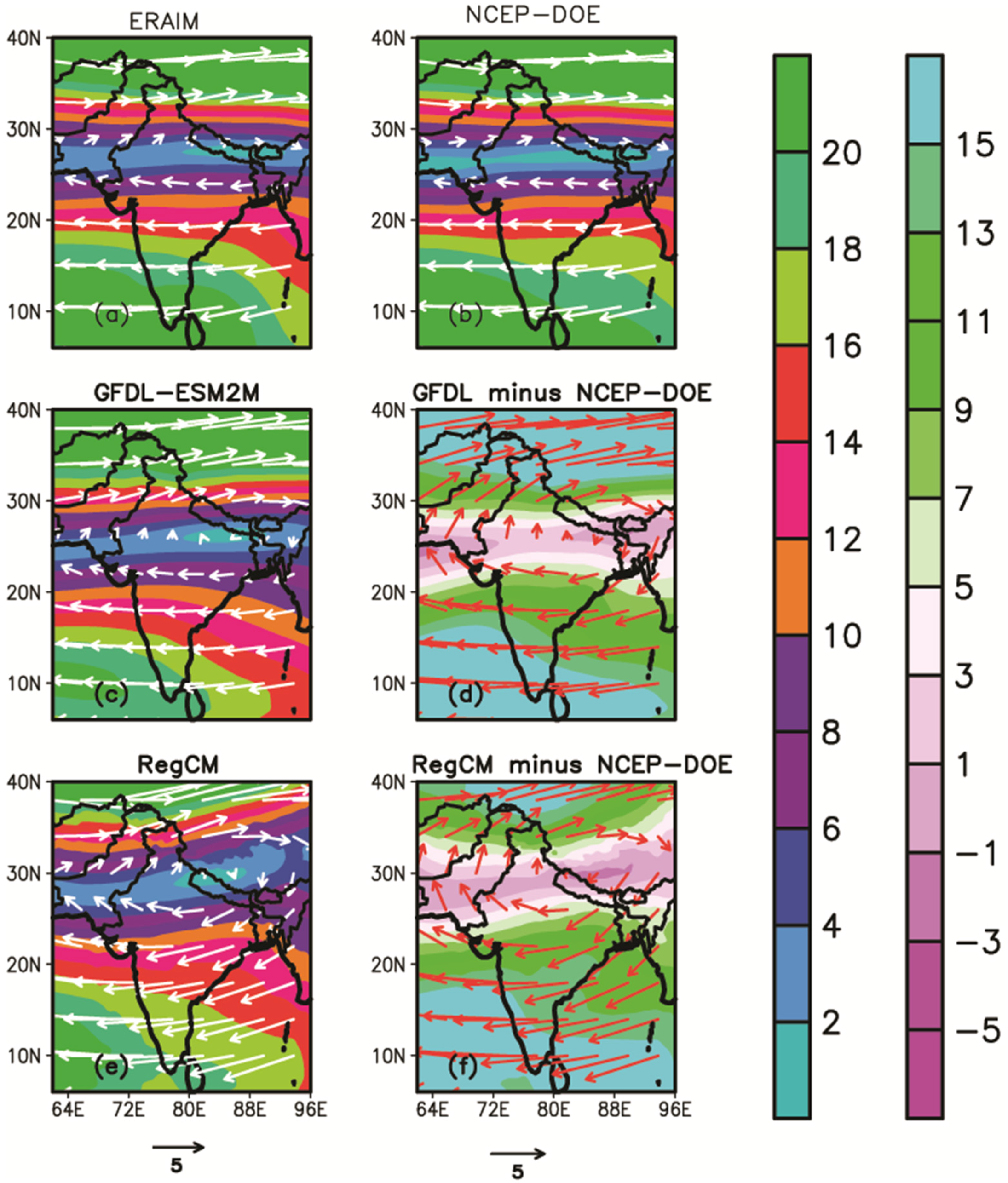
| -- | ERAIM | NCEP−DOE | GFDL | RegCM4 |
|---|---|---|---|---|
| ERAIM | 1.00 | 0.92 | 0.45 | 0.52 |
| NCEP−DOE | 0.92 | 1.00 | 0.32 | 0.40 |
| GFDL | 0.45 | 0.32 | 1.00 | 0.95 |
| RegCM4 | 0.52 | 0.40 | 0.95 | 1.00 |
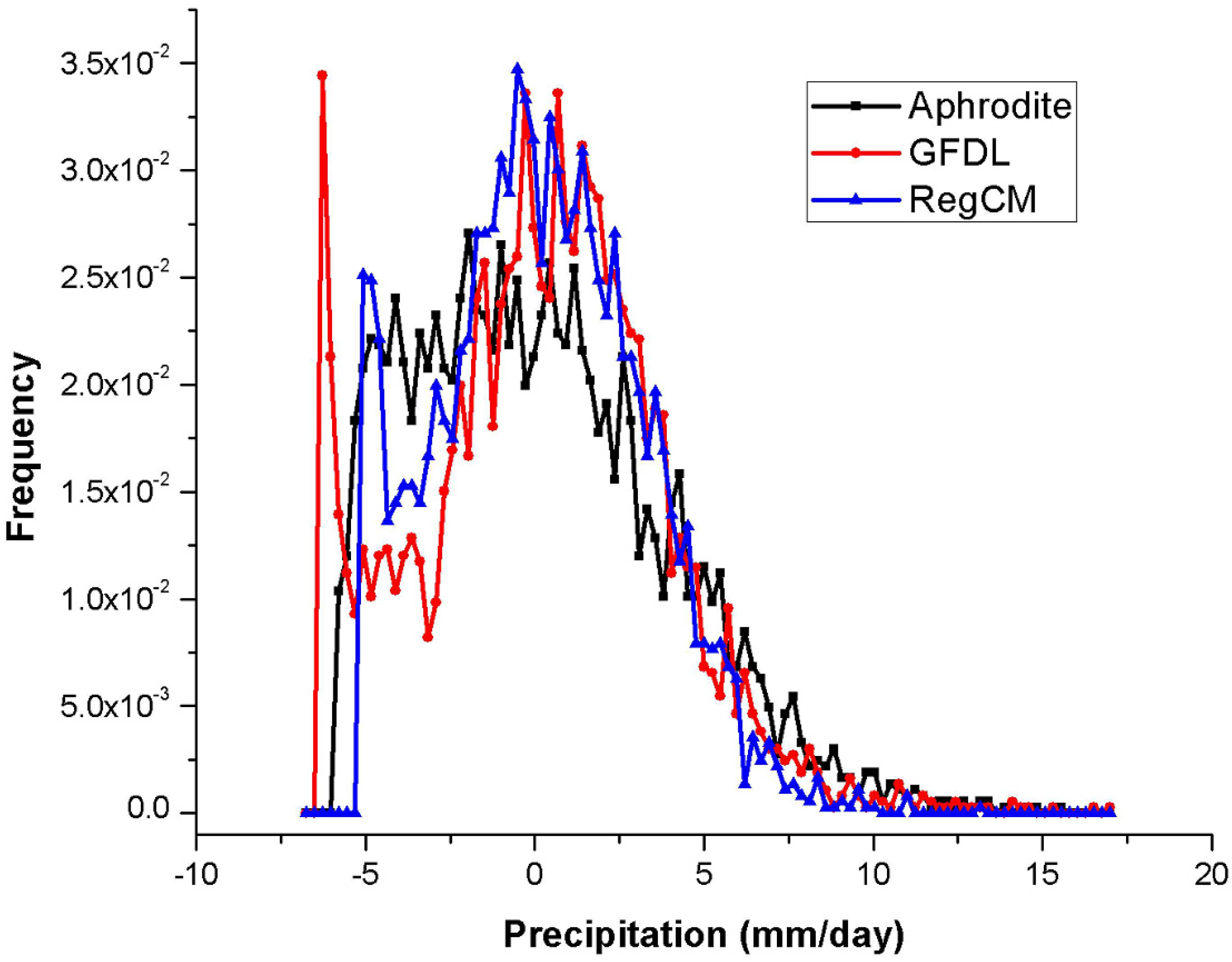
3.2. Assessment of Climate Change Signal for SASM


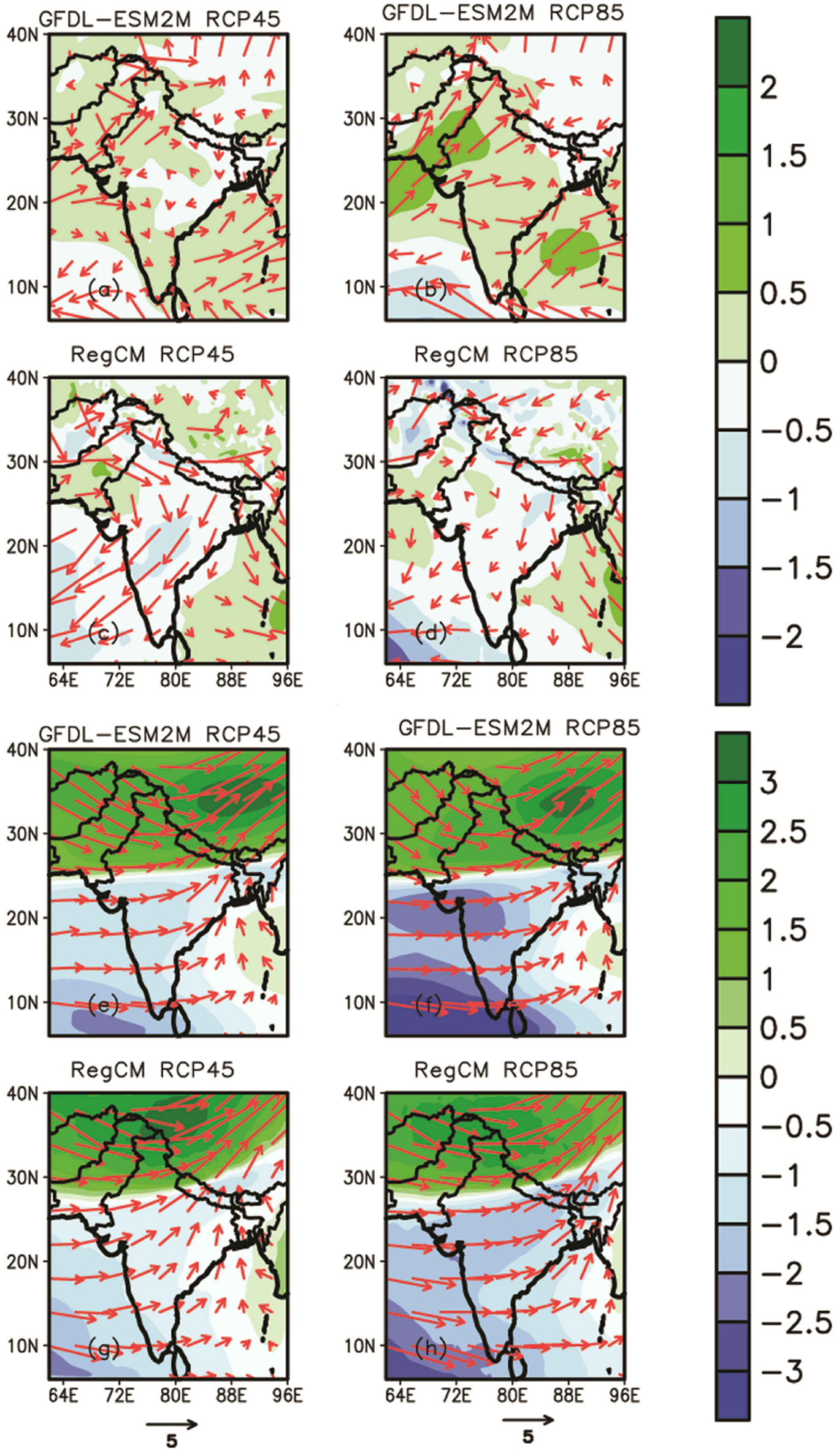

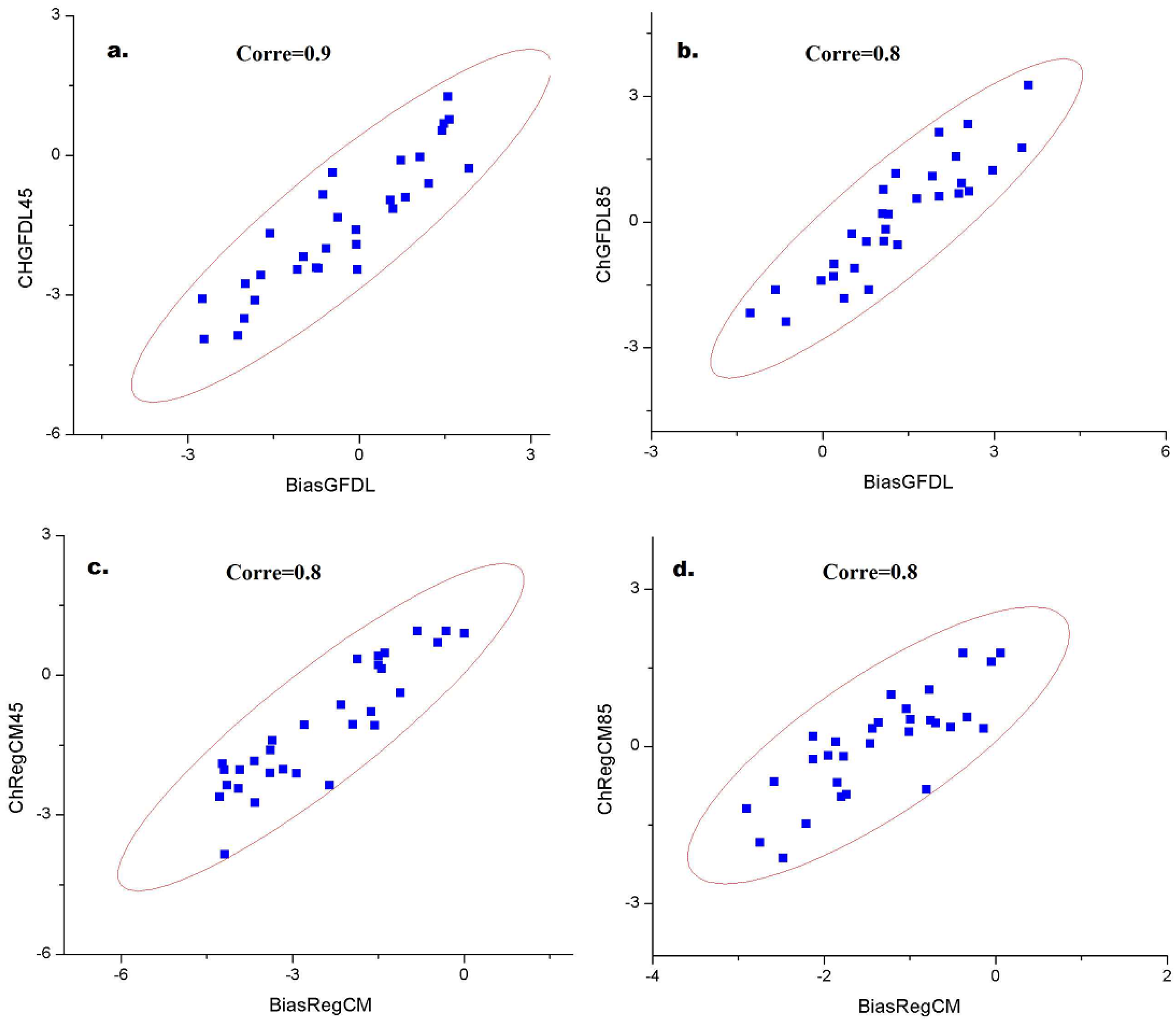

4. Conclusions
Supplementary Files
Supplementary File 1Acknowledgments
Author Contributions
Conflicts of Interest
References
- IPCC. Summary for Policymakers. In Climate Change: The Physical Science Basis. Contribution of Working Group I to the Fifth Assessment Report of the Intergovernmental Panel on Climate Change; Stocker, T.F., Qin, D., Plattner, G.-K., Tignor, M., Allen, S.K., Boschung, J., Nauels, A., Xia, Y., Bex, V., Midgley, P.M., Eds.; Cambridge University Press: Cambridge, UK; New York, NY, USA, 2013; pp. 1–32. [Google Scholar]
- Hsu, P.C.; Li, T.; Luo, J.J.; Murakami, H.; Kitoh, A.; Zhao, M. Increase of global monsoon area and precipitation under global warming: A robust signal? Geophys. Res. Lett. 2012, 39. [Google Scholar] [CrossRef]
- Lau, W.K.M.; Wu, H.T.; Kim, K.M. A canonical response of precipitation characteristics to global warming from CMIP5 models. Geophys. Res. Lett. 2013, 40, 3163–3169. [Google Scholar] [CrossRef]
- Lee, J.-Y.; Wang, B. Future change of global monsoons in the CMIP5. Clim. Dyn. 2014, 42, 101–119. [Google Scholar] [CrossRef]
- Turner, A.G.; Annamalai, H. Climate change and the south Asian summer monsoon. Nat. Clim. Chang. 2012, 2, 587–595. [Google Scholar] [CrossRef]
- Syed, F.S.; Iqbal, W.; Syed, A.A.B.; Rasul, G. Uncertainties in the regional climate models simulations of South-Asian summer monsoon and climate change. Clim. Dyn. 2014, 42, 2079–2097. [Google Scholar] [CrossRef]
- Goswami, B.B.; Mani, N.J.; Mukhopadhyay, P.; Waliser, D.E.; Benedict, J.J.; Maloney, E.D.; Khairoutdinov, M.; Goswami, B.N. Monsoon intraseasonal oscillations as simulated by the superparameterized Community Atmosphere Model. J. Geophys. Res. 2011, 116. [Google Scholar] [CrossRef]
- Ashfaq, M.; Shi, Y.; Tung, W.; Trapp, R.J.; Gao, T.X.; Pal, J.S.; Diffenbaugh, N.S. Suppression of south Asian summer monsoon precipitation in the 21st century. J. Geophys. Res. 2009, 36. [Google Scholar] [CrossRef]
- Hussain, I.G.; Spock, J.P.; Yu, H.L. Spatio-temporal interpolation of precipitation during monsoon period in Pakistan. Adv. Water Resour. 2010, 33, 880–886. [Google Scholar] [CrossRef]
- Webster, P.J.; Toma, V.E.; Kim, H.M. Were the 2010 Pakistan floods predictable? Geophys. Res. Lett. 2011, 38. [Google Scholar] [CrossRef]
- Pai, D.S.; Sreejith, O.P. Global and regional circulation anomalies: Monsoon. Available online: http://www.imd.gov.in/section/nhac/dynamic/monsoon_report_2010.pdf (accessed on 5 September 2015).
- Taylor, K.E.; Stouffer, R.J.; Meehl, G.A. An overview of CMIP5 and the experiment design. Bull. Am. Meteorol. Soc. 2012, 93, 485–498. [Google Scholar] [CrossRef]
- Sperber, K.R.; Annamalai, H.; Kang, I.-S.; Kitoh, A.; Moise, A.; Turner, A.; Wang, B.; Zhou, T. The Asian summer monsoon: An inter-comparison of CMIP5 vs. CMIP3 simulations of the late 20th century. Clim. Dyn. 2012, 41, 2711–2744. [Google Scholar] [CrossRef]
- Wang, B.; Yim, S.Y.; Lee, J.-Y.; Liu, J.; Ha, K.J. Future change of Asian-Australian monsoon under RCP 4.5 anthropogenic warming scenario. Clim. Dyn. 2014, 42, 83–100. [Google Scholar] [CrossRef]
- Krishnamurti, T.N.; Stefanova, L.; Chakraborty, A.; Kumar, T.S.V.V.; Cocke, S.; Bachiochi, D.; Mackey, B. Seasonal forecasts of precipitation anomalies for North American and Asian monsoons. J. Meteorol. Soc. Jpn. 2002, 80, 1415–1426. [Google Scholar] [CrossRef]
- Kang, I.-S.; Lee, J.; Park, C.K. Potential predictability of summer mean precipitation in a dynamical seasonal prediction system with systematic error correction. J. Clim. 2004, 17, 834–844. [Google Scholar] [CrossRef]
- Wang, B.; Ding, Q.; Fu, X.; Kang, I.-S.; Jin, K.; Shukla, J.; Doblas-Reyes, F. Fundamental challenge in simulation and prediction of summer monsoon rainfall. Geophys. Res. Lett. 2005, 32. [Google Scholar] [CrossRef]
- Feng, J.; Fu, C. Inter-comparison of 10-year precipitation simulated by several RCMs for Asia. Adv. Atmos. Sci. 2006, 23, 531–542. [Google Scholar] [CrossRef]
- Saeed, S.; Muller, W.A.; Hagemann, S.; Jacob, D.; Mujumdar, M.; Krishnan, R. Precipitation variability over the South Asian monsoon heat low and associated teleconnections. Geophys. Res. Lett. 2011, 38. [Google Scholar] [CrossRef]
- Sharmila, S.; Joseph, S.; Sahai, A.K.; Abhilash, S.; Chattopadhyay, R. Future projection of India summer monsoon variability under climate change scenario: An assessment from CMIP5 climate models. Glob. Planet. Chang. 2014, 124, 62–78. [Google Scholar] [CrossRef]
- Von Storch, H.; Zorita, E.; Cubasch, U. Downscaling of global climate change estimates to regional scales: An application to Iberian rainfall in wintertime. J. Clim. 1993, 6, 1161–1171. [Google Scholar] [CrossRef]
- Ding, T.; Ke, Z. A comparison of statistical approach for seasonal precipitation prediction in Pakistan. Weather Forecast 2013, 32, 1116–1132. [Google Scholar] [CrossRef]
- Raju, A.; Parekh, A.; Chowdary, J.S.; Gnanaseelan, C. Assessment of the Indian summer monsoon in the WRF regional climate model. Clim. Dyn. 2015, 44, 3077–3100. [Google Scholar] [CrossRef]
- Ratana, S.B.; Ratnam, J.V.; Behera, A.K.; Rautenbach, C.J.; Ndarana, T.; Takahashi, K.; Yamagata, T. Performance assessment of three convective parameterization schemes in WRF for downscaling summer rainfall over South Africa. Clim. Dyn. 2013, 42, 2931–2953. [Google Scholar] [CrossRef]
- Da Rocha, R.P.; Cuadra, S.V.; Reboita, M.S.; Kruger, L.F.; Amrizzi, T.; Krusche, N. Effects of RegCM3 parameterizations on simulated rainy season over South America. Clim. Res. 2012, 52, 253–265. [Google Scholar] [CrossRef]
- Bhaskaran, B.; Jones, R.G.; Murphy, J.M.; Noguer, M. Simulations of the Indian summer monsoon using a nested climate model: Domain size experiments. Clim. Dyn. 1996, 12, 573–587. [Google Scholar] [CrossRef]
- Vernekar, A.D.; Ji, Y. Simulation of the onset and intraseasonal variability of two contrasting summer monsoons. J. Clim. 1999, 12, 1707–1725. [Google Scholar] [CrossRef]
- Bhaskar, D.V.; Ashok, K.; Yamagata, T. A numerical simulation study of the Indian summer monsoon of 1994 using NCAR MM5. J. Meteorol. Soc. Jpn. 2004, 82, 1755–1777. [Google Scholar] [CrossRef]
- Dash, S.K.; Shekhar, M.S.; Singh, G.P. Simulation of Indian summer monsoon circulation and rainfall using RegCM3. Theor. Appl. Climatol. 2006, 86, 161–172. [Google Scholar] [CrossRef]
- Islam, S.; Rehman, N.; Sheikh, M.M. Future change in the frequency of warm and cold spells durations over Pakistan simulated by the PRECIS regional climate model. Clim. Chang. 2009, 94, 35–45. [Google Scholar] [CrossRef]
- Dobler, A.; Ahrens, B. Analysis of the Indian summer monsoon system in the regional climate model COSMO-CLM. J. Geophys. Res. 2010, 115. [Google Scholar] [CrossRef]
- Hariprasad, D.; Venkata, S.C.; Bhaskar, R.D.; Anjaneyulu, Y. Simulation of Indian monsoon extreme rainfall events during the decadal period 2000–2009 using a high resolution mesoscale model. Adv. Geosci. 2011, A6, 31–48. [Google Scholar]
- Lucas-Picher, P.; Christensen, J.H.; Saeed, F.; Kumar, P.; Asharaf, S.; Ahrens, B.; Wilshire, A.J.; Jacob, D.; Hegemann, S. Can Regional Climate Models Represent the Indian Monsoon? J. Hydrometrol. 2011, 12, 849–868. [Google Scholar] [CrossRef]
- Saeed, F.; Hagemann, S.; Jacob, D. A framework for the evaluation of the South Asian summer monsoon in a regional climate model applied to REMO. Int. J. Climatol. 2012, 32, 430–440. [Google Scholar] [CrossRef]
- Dash, S.K.; Mishra, S.K.; Pattnayak, K.C.; Manmgain, A.; Mariotti, L.; Coppola, E.; Giorgi, F.; Giuliani, G. Projected seasonal mean summer monsoon over India and adjoining regions for the twenty-first century. Theor. Appl. Climatol. 2014. [Google Scholar] [CrossRef]
- Tawfik, A.B.; Steiner, A.L. The role of soil ice in land–atmosphere coupling over the United States: A soil moisture precipitation winter feedback mechanism. J. Geophys. Res. 2011, 116. [Google Scholar] [CrossRef]
- Giorgi, F.; Coppola, E.; Solmon, F.; Mariotti, L.; Sylla, M.B.; Bi, X.; Elguindi, N.; Diro, G.T.; Nair, V.; Giuliani, G.; et al. RegCM4: Model description and preliminary tests over multiple CORDEX domains. Clim. Res. 2012, 52, 7–29. [Google Scholar] [CrossRef]
- Dickinson, R.E.; Errico, R.M.; Giorgi, F.; Bates, G.T. A regional climate model for the western United States. Clim. Chang. 1989, 15, 383–422. [Google Scholar] [CrossRef]
- Giorgi, F. Simulation of regional climate using a limited area model nested in a general circulation model. J. Clim. 1990, 3, 941–963. [Google Scholar] [CrossRef]
- Giorgi, F.; Marinucci, M.R.; Bates, G. Development of a second generation regional climate model (RegCM2). I. Boundary layer and radiative transfer processes. Mon. Weather Rev. 1993, 121, 2794–2813. [Google Scholar] [CrossRef]
- Giorgi, F.; Mearns, L.O. Introduction to special section: Regional climate modeling revisited. J. Geophy. Res. 1999, 104, 6335–6352. [Google Scholar] [CrossRef]
- Pal, J.S.; Giorgi, F.; Bi, X.; Elguindi, N.; Solmon, F.; Rauscher, S.A. Regional climate modeling for the developing world: The ICTP Reg-CM3 and RegCNET. Bull. Am. Meteorol. Soc. 2007, 88, 1395–1409. [Google Scholar] [CrossRef]
- Grell, G.; Dudhia, J.; Stauffer, D.R. A Description of the Fifth Generation Penn State/NCAR Mesoscale Model (MM5); National Center for Atmospheric Research Technical Note; NCAR/TN-398 STR; NCAR: Boulder, CO, USA, 1994. [Google Scholar]
- Dickinson, R.E.; Henderson-Sellers, A.; Kennedy, P. Bio-Sphere-Atmosphere Transfer Scheme (BATS) Version 1e As Coupled to the NCAR Community Climate Model; National Center for Atmospheric Research Technical Note; NCAR.TN-387-STR; NCAR: Boulder, CO, USA, 1993. [Google Scholar]
- Oleson, K.W.; Niu, G.; Yang, Z.L.; Lawrence, D.M.; Lawrence, P.E.; Thornton, P.J.; Lawrence, R.; Stöckli, R.E.; Dickinson, G.B.; Bonan, S.; et al. Improvements to the community land model and their impact on the hydrologic cycle. J. Geophys. Res. 2008, 113. [Google Scholar] [CrossRef]
- Steiner, A.L.; Pal, J.S.; Rauscher, S.A.; Bell, J.L.; Diffenbaugh, N.S.; Boone, A.; Sloan, L.C.; Giorgi, F. Land surface coupling in regional climate simulations of the West Africa monsoon. Clim. Dyn. 2009, 33, 869–892. [Google Scholar] [CrossRef]
- Kiehl, J.T.; Hack, J.J.; Bonan, G.B.; Boville, B.A.; Breigleb, B.P. Description of the NCAR Community Climate Model (CCM3). Available online: http://www.osti.gov/scitech/biblio/442361 (accessed on 5 September 2015).
- Briegleb, B.P. Delta-Eddington approximation for solar radiation in the NCAR Community Climate Mode. J. Geophys. Res. 1992, 97, 7603–7612. [Google Scholar] [CrossRef]
- Pal, J.S.; Small, E.; Eltahi, E. Simulation of regional-scale water and energy budgets: Representation of sub grid cloud and precipitation processes within RegCM. J. Geophys. Res. 2000, 105, 29579–29594. [Google Scholar] [CrossRef]
- Holtslag, A.; Bruijn, E.; Pan, H.L. A high resolution air mass transformation model for short-range weather forecasting. Mon. Weather Rev. 1990, 118, 1561–1575. [Google Scholar] [CrossRef]
- Anthes, R.A.; Hsie, E.Y.; Kuo, Y.H. Description of the Penn State/NCAR Mesoscale Model Version 4 (MM4); National Center for Atmospheric Research Technical Note; TN-282STR; NCAR: Boulder, CO, USA, 1987. [Google Scholar]
- Grell, G.A. Prognostic evaluation of assumptions used by cumulus parameterization. Mon. Weather. Rev. 1993, 12, 764–787. [Google Scholar] [CrossRef]
- Arakawa, A.; Schubert, W.H. Interaction of a cumulus cloud ensemble with the large-scale environment, part I. J. Atmos. Sci. 1974, 31, 674–701. [Google Scholar] [CrossRef]
- Fritsch, J.; Chappell, C. Numerical prediction of convectively driven mesoscale pressure systems. I. Convective parameterization. J. Atmos. Sci. 1980, 37, 1722–1733. [Google Scholar] [CrossRef]
- Emanuel, K.A. A scheme for representing cumulus convection in large-scale models. J. Atmos. Sci. 1991, 48, 2313–2335. [Google Scholar] [CrossRef]
- Emanuel, K.A.; Zivkovic-Rothman, M. Development and evaluation of a convection scheme for use in climate models. J. Atmos. Sci. 1999, 56, 1766–1782. [Google Scholar] [CrossRef]
- Tiedtke, M. A comprehensive mass-flux scheme for cumulus parameterization in large-scale models. Mon. Weather Rev. 1989, 117, 1779–1800. [Google Scholar] [CrossRef]
- Coppola, E.; Giorgi, F.; Raffaele, F.; Fuentes-Franco, R.; Giuliani, G.; LLopart-Pereira, M.; Mamgain, A.; Mariotti, L.; Diro, G.T.; Torma, C. Present and future climatologies in the phase I CREMA experiment. Clim. Chang. 2014, 125, 23–38. [Google Scholar] [CrossRef]
- Loverland, T.R.; Reed, B.C.; Brown, J.F.; Ohlen, D.O.; Zhu, Z.; Yang, L.; Merchant, J.W. Development of a global land cover characteristics database and IGBP DISCover from 1 km AVHRR data. Int. J. Remote. Sens. 2000, 21, 1303–1365. [Google Scholar] [CrossRef]
- Mitchell, T.D.; Jones, P.D. An improved method of constructing a database of monthly climate observations and associated high resolution grids. Int. J. Climatol. 2005, 25, 693–712. [Google Scholar] [CrossRef]
- Yatagai, A.; Kenji, K.; Osamu, A.; Atsushi, H.; Natsuko, Y.; Akio, K. APHRODITE: Constructing a long-term daily gridded precipitation dataset for Asia based on a dense network of rain gauges. Bull. Am. Meteor Soc. 2012, 93, 1401–1415. [Google Scholar] [CrossRef]
- Rao, Y.P.; Ramamurti, K.S. Climatology of India and neighborhood. Available online: http://www.imdpune.gov.in/weather_forecasting/Forecasting_Mannuals/IMD_I-2.pdf (accessed on 5 September 2015).
- Srinivas, C.V.; Hariprasad, D.; Bhaskar, R.D.V.; Anjaneyulu, Y.; Baskarana, R.; Venkataramana, B. Simulation of the Indian summer monsoon regional climate using advanced research WRF model. Int. J. Climatol. 2012. [Google Scholar] [CrossRef]
- Rajeevan, M.; Gadgil, S.; Bhate, J. Active and break spells of the Indian summer monsoon. J. Earth Syst. Sci. 2010, 119, 229–247. [Google Scholar] [CrossRef]
- Van Vuuren, D.P.; Edmonds, J.; Kainuma, M.; Riahi, K.; Thomson, A.; Hibbard, K.; Hurtt, G.C.; Kram, T.; Krey, V.; Lamarque, J.-F.; et al. The representative concentration pathways: An overview. Clim. Chang. 2011, 109, 5–31. [Google Scholar] [CrossRef]
- Meinshausen, M.; Smith, S.J.; Calvin, K.; Daniel, J.S.; Kainuma, M.L.T.; Lamarque, J.F.; Matsumoto, K.; Montzka, S.A.; Raper, S.C.B.; Riahi, K.; et al. The RCP greenhouse gas concentrations and their extensions from 1765 to 2300. Clim. Chang. 2001. [Google Scholar] [CrossRef]
- Lamarque, J.F.; Page, K.G.; Meinshause, M.; Riahi, K.; Smith, S.; van Vuuren, D.P.; Conley, A.J.; Vitt, F. Global and regional evolution of short-lived radiatively-active gases and aerosols in the representative concentration pathways. Clim. Chang. 2011. [Google Scholar] [CrossRef]
- New, M.G.; Hulme, M.; Jones, P.D. Representing twentieth century space time climate variability. Part 1. Development of a 1961–1990 mean monthly terrestrial climatology. J. Clim. 1999, 12, 829–856. [Google Scholar] [CrossRef]
- Nikulin, G. Precipitation climatology in an ensemble of CORDEX Africa regional climate simulations. J. Clim. 2012, 25, 6057–6078. [Google Scholar] [CrossRef]
- Sylla, M.B.; Giorgi, F.; Coppola, E.; Mariotti, L. Uncertainties in daily rainfall over Africa: Assessment of gridded observation products and evaluation of a regional climate model simulation. Int. J. Climatol. 2012. [Google Scholar] [CrossRef]
- Gu, H.; Wang, G.; Yu, Z.; Mei, R. Assessing future climate changes and extreme indicators in east and south Asia using RegCM regional climate model. Clim. Chang. 2012, 114, 301–317. [Google Scholar] [CrossRef]
- Giorgi, F.; Huang, Y.; Nishizawa, K.; Fu, C. A seasonal cycle simulation over eastern Asia and its sensitivity to radioactive transfer and surface processes. J. Geophys. Res. 1999, 104, 6403–6423. [Google Scholar] [CrossRef]
- Ullah, K.; Gao, S.T. Moisture transport over the Arabian associated with the summer rainfall over Pakistan in 1994 and 2002. Adv. Atmos. Sci. 2012, 29, 501–508. [Google Scholar] [CrossRef]
- Krishnamurti, T.N.; Bhalme, H.N. Oscillations of a monsoon system, Part I: Observational aspects. J. Atmos. Sci. 1976, 33, 1937–1954. [Google Scholar] [CrossRef]
- Mariotti, L.; Coppola, E.; Sylla, M.B.; Giorgi, F.; Piani, C. Regional climate model simulation of projected 21st century climate change over an all-Africa domain: Comparison analysis of nested and driving model results. J. Geophys. Res. Atmos. 2013. [Google Scholar] [CrossRef]
- Di Luca, A.; de Elia, R.; Laprise, R. Potential for small scale added value of RCM’s downscaled climate change signal. Clim. Dyn. 2013, 40, 601–618. [Google Scholar] [CrossRef]
- Kazmi, D.H.; Li, J.; Rasul, G.; Tong, J.; Ali, G.; Cheema, S.B.; Liu, L.; Gemmer, M.; Fischer, T. Statistical downscaling and future scenario generation of temperature for Pakistan regions. Theor. Appl. Climatol. 2014, 120, 341–350. [Google Scholar] [CrossRef]
- Kumr, A.; Wiltshire, A.; Mathison, C.; Asharaf, S.; Ahrens, B.; Lucas-Picher, P.; Christensen, J.H.; Gobiet, A.; Saeed, F.; Hagemann, S.; et al. Downscaled climate change projections with uncertainty assessment over India using a high resolution multi-model approach. Sci. Total Environ. 2013, 468–469, S18–S30. [Google Scholar] [CrossRef] [PubMed]
- Boberg, F.; Christensen, J.H. Overestimation of Mediterranean summer temperature projections due to model deficiencies. Nat. Clim. Chang. 2012, 2, 433–436. [Google Scholar] [CrossRef]
- Cook, E.R.; Anchunkaitis, K.J.; Buckley, B.M.; D’Arrigo, R.D.; Jacoby, G.C.; Wright, W.E. Asian Monsoon failure and magadrought during the last millennium. Science 2010, 328, 486–489. [Google Scholar] [CrossRef] [PubMed]
© 2015 by the authors; licensee MDPI, Basel, Switzerland. This article is an open access article distributed under the terms and conditions of the Creative Commons Attribution license (http://creativecommons.org/licenses/by/4.0/).
Share and Cite
Hassan, M.; Du, P.; Jia, S.; Iqbal, W.; Mahmood, R.; Ba, W. An Assessment of the South Asian Summer Monsoon Variability for Present and Future Climatologies Using a High Resolution Regional Climate Model (RegCM4.3) under the AR5 Scenarios. Atmosphere 2015, 6, 1833-1857. https://doi.org/10.3390/atmos6111833
Hassan M, Du P, Jia S, Iqbal W, Mahmood R, Ba W. An Assessment of the South Asian Summer Monsoon Variability for Present and Future Climatologies Using a High Resolution Regional Climate Model (RegCM4.3) under the AR5 Scenarios. Atmosphere. 2015; 6(11):1833-1857. https://doi.org/10.3390/atmos6111833
Chicago/Turabian StyleHassan, Mujtaba, Pengfei Du, Shaofeng Jia, Waheed Iqbal, Rashid Mahmood, and Wulong Ba. 2015. "An Assessment of the South Asian Summer Monsoon Variability for Present and Future Climatologies Using a High Resolution Regional Climate Model (RegCM4.3) under the AR5 Scenarios" Atmosphere 6, no. 11: 1833-1857. https://doi.org/10.3390/atmos6111833






